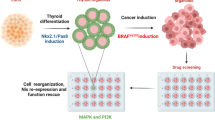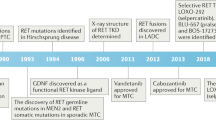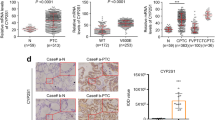Abstract
RET/PTC1 is a rearranged form of the RET proto-oncogene detected in human papillary thyroid carcinomas. We previously showed that thyroid-targeted expression of RET/PTC1 leads to thyroid tumor formation in Tg-PTC1 transgenic mice. Signal transduction pathways mediated by phosphotyrosine 294, 404, or 451 in RET/PTC1 have been shown to be critical for RET-induced transforming activity in vitro. To investigate the contribution of these signaling pathways in RET/PTC1-induced thyroid tumor formation in vivo, we generated and characterized transgenic mice expressing thyroid-targeted RET/PTC1 mutants carrying a site-directed mutation changing tyrosine (Y) to phenylalanine (F) at the residue 294, 404, or 451. In contrast to the 100% tumor formation rate in Tg-PTC1 transgenic mice, tumor formation rates were significantly decreased in Tg-PTC1-Y294F (6%), Tg-PTC1-Y404F (41%), and Tg-PTC1-Y451F (30%) transgenic mice. This indicates that signaling pathways mediated by pY294, pY404, and pY451 do play a role in RET/PTC1-induced tumor formation. However, as tumors are still able to form in some mice within these three mutant transgenic groups, it indicates that none of the signaling pathways mediated by pY294, pY404, or pY451, are solely essential for RET/PTC1-induced tumor formation.
This is a preview of subscription content, access via your institution
Access options
Subscribe to this journal
Receive 50 print issues and online access
$259.00 per year
only $5.18 per issue
Buy this article
- Purchase on Springer Link
- Instant access to full article PDF
Prices may be subject to local taxes which are calculated during checkout





Similar content being viewed by others
References
Berridge MJ, Irvine RF . 1989 Nature 341: 197–205
Cho JY, Sagartz JE, Capen CC, Mazzaferri EL, Jhiang SM . 1999 Oncogene 18: 3659–3665
Jhiang SM, Sagartz JE, Tong Q, Parker-Thornberg J, Capen CC, Cho JY, Xing S, Ledent C . 1996 Endocrinology 137: 375–378
Jhiang SM . 2000 Oncogene 19: 5590–5597
Kato M, Liu W, Akhand AA, Dai Y, Ohbayashi M, Tuzuki T, Suzuki H, Isobe KI, Takahashi M, Nakashima I . 1999 Oncogene 18: 837–842
Kato M, Takeda K, Kawamoto Y, Iwashita T, Akhand AA, Senga T, Yamamoto M, Sobue G, Hamaguchi M, Takahashi M, Nakashima I . 2002 Oncogene 62: 2414–2422
Powell Jr D, Russell JP, Li G, Kuo BA, Fidanza V, Huebner K, Rothstein JL . 2001 Oncogene 20: 3235–3246
Santoro M, Chiapetta G, Cerrato A, Salvatore D, Zhang L, Manzo G, Picone A, Portella G, Santelli G, Vecchio G, Fusco A . 1996 Oncogene 12: 1821–1826
Sweetser DA, Froelick GJ, Matsumoto AM, Kafer KE, Marck B, Palmiter RD, Kapur RP . 1999 Oncogene 18: 877–886
Tallini G, Asa SL . 2001 Adv. Anat. Pathol. 8: 345–354
Van Weering DH, Bos JL . 1998 Recent Results Cancer Res. 154: 271–281
Xing S, Furminger TL, Tong Q, Jhiang SM . 1998 J. Biol. Chem. 273: 4909–4914
Acknowledgements
This work was supported in part by National Institutes of Health Grant RO1 CA60074 (to SM Jhiang).
Author information
Authors and Affiliations
Corresponding author
Rights and permissions
About this article
Cite this article
Buckwalter, T., Venkateswaran, A., Lavender, M. et al. The roles of phosphotyrosines-294, -404, and -451 in RET/PTC1-induced thyroid tumor formation. Oncogene 21, 8166–8172 (2002). https://doi.org/10.1038/sj.onc.1205938
Received:
Revised:
Accepted:
Published:
Issue Date:
DOI: https://doi.org/10.1038/sj.onc.1205938
Keywords
This article is cited by
-
The insulin resistance Grb14 adaptor protein promotes thyroid cancer ret signaling and progression
Oncogene (2012)
-
Synergistic growth inhibition of cancer cells harboring the RET/PTC1 oncogene by staurosporine and rotenone involves enhanced cell death
Journal of Biosciences (2011)
-
Autocrine stimulation by osteopontin plays a pivotal role in the expression of the mitogenic and invasive phenotype of RET/PTC-transformed thyroid cells
Oncogene (2004)
-
Functional expression of the CXCR4 chemokine receptor is induced by RET/PTC oncogenes and is a common event in human papillary thyroid carcinomas
Oncogene (2004)



